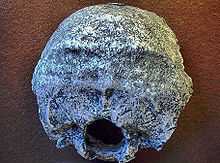External occipital protuberance
From Wikipedia, the free encyclopedia
| External occipital protuberance | |
|---|---|
 | |
| Human skull lateral view. External occipital protuberance shown in red. | |
 | |
| Occipital bone seen from below. Outer surface. (External occipital protuberance visible at top center.) | |
| Latin | protuberantia occipitalis externa |
| Gray's | subject #46 185 |
Near the middle of the occipital squama is the external occipital protuberance, and extending lateralward from it on either side is the superior nuchal line, and above this the faintly marked highest nuchal line.
It is less pronounced in females.[1]
The inion is the highest point of the external occipital protuberance.
A projection on the external surface of the squamous part of the occipital bone in the midline
Additional images
|
See also
References
- ↑ Gülekon, IN. "The external occipital protuberance: can it be used as a criterion in the determination of sex?". PubMed. National Center for Biotechnology Information. Retrieved 9 December 2013.
External links
| Wikimedia Commons has media related to External occipital protuberance. |
- external+occipital+protuberance at eMedicine Dictionary
- Roche Lexicon - illustrated navigator, at Elsevier 34257.000-1
- http://www.upstate.edu/cdb/grossanat/hnsklatob1.shtml
This article incorporates text from a public domain edition of Gray's Anatomy.
| ||||||||||||||||||||||||||||||||||||||||||||||||||||||||||||||||||||||||||
This article is issued from Wikipedia. The text is available under the Creative Commons Attribution/Share Alike; additional terms may apply for the media files.




